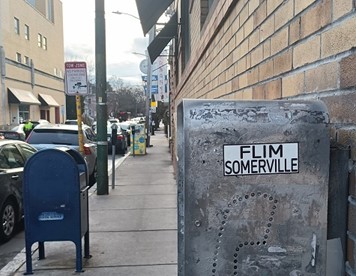Every movie is a documentary of its making. Or a documentary of what the makers want you to believe about that making, about where it was made. Make enough movies in the same place over time and you get a history, a collection of narratives linked by location. What does that history say about that place? These are lofty thoughts, perhaps they should be brought to earth. Why is Burt Reynolds, with trademark mustache, dressed as a nun and chasing a dude through one of Boston’s oldest public parks?
Reynolds is doing this in the 1972 film Fuzz, one of more than 200 movies featured in Made in Massachusetts: 100 Years of Filmmaking in the Bay State. (For simplicity’s sake, I’ll refer to this as MiM for the rest of the article.) Created by Adam Roffman, who’s worked as set dresser for numerous Boston flicks in the past two decades, and producer/editor Vatche Arabian, MiM proceeds chronologically through clips from a century of Massachusetts location shooting, from Captains Courageous to Eddie Coyle to CODA. Roffman and Arabian searched out and compiled the clips on their own time and did not clear anything, rights-wise — I saw this in a free screening at the Brattle, the godfather of arthouse cinema in Cambridge, and when introducing the film Roffman and Arabian said it was intended as an academic work and would likely not be shown publicly in the future. The movie is not the East Coast equivalent of Los Angeles Plays Itself — there is no essayistic comment or connection between clips to argue a larger point — but it still shows larger currents of cinema moving through the state and the state creating eddies of its own.
Roffman and Arabian did this for free, hunting down hundreds of movies (some pretty hard if not nearly impossible to find) and cutting their Mass footage — with an emphasis on letting scenes play out in order to give some context to the viewer — before stitching it all together again. A Boston Globe write-up of the film calls it a labor of love and I’m not going to criticize people who did this much unpaid work for not doing even more. But if there’s one thing I wish MiM could have done, it would be to be more playful and associative with its footage, creating connections outside of following a strict chronology. The filmmakers make connections when the chronology lets them — I assume having Love Story slam into The Honeymoon Killers was intentional — but there are more opportunities for echoes and themes, like recurring filmmakers (alleged Chicagoan David Mamet has filmed half a dozen movies here, was he a Masshole this whole time?) and more interestingly recurring actors and locations.
A baby-faced Jake Gyllenhaal hangs out in Gloucester in 2002’s Moonlight Mile before reappearing, eyes still wide but haggard with fear, 15 years later in the Boston Marathon docudrama Stronger. Gyllenhaal’s character waves a flag in a ceremony during a Bruins game at the TD Garden, the all-frills basketball/hockey arena that replaced the original Boston Garden, where helmetless hockey players roamed the ice and still didn’t suffer as much brain damage as Robert Mitchum slurping shitty beer in paper cups in 1973’s The Friends Of Eddie Coyle. These connections are present over the course of MiM, but I was imagining them tied together without dozens of films between them, letting the images link up and counterpoint. The sea is the first thing we see, real whaling footage off the coast of New Bedford used in the 1922 drama Down To The Sea In Ships, and fishing in particular is a major presence. There’s the family of the Oscar-winning CODA of course, and the doomed fishermen in The Perfect Storm — but there are also a bunch of knuckleheads in Squeeze hitting the coast by the Rainbow Swash gas tank in Dorchester, looking to haul in some bass (“it’s short for Big-Ass Fish”), young and black instead of grizzled and white, a different version of an image shown over and over.
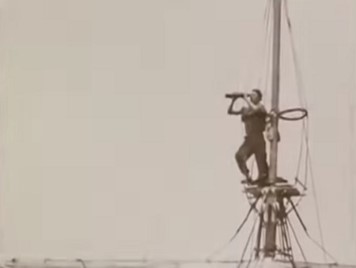
There are several early silent films that have Massachusetts footage, but Roffman and Arabian said they wanted to specifically focus on a century of filmmaking in the Commonwealth and limited their survey to 1922-2022 (meaning several 2023 films missed the cut too) And they don’t include every film with Massachusetts locations made during that time — at the screening, Roffman mentioned generally focusing on fiction films, and the occasional TV show, that chose to shoot in the Bay State as opposed to documentaries finding stories here. But while MiM includes Frederick Wiseman’s 2020 doc City Hall, Wiseman’s 1967 debut Titicut Follies — banned across the country for decades after politicians balked at its footage of a horribly run state-run mental hospital — didn’t make the cut. If nothing else it would have fit in with the mental hospital footage of 2001’s Session Nine and the fascinating-looking short Met State. The classic 1969 Maysles/Zwerin doc Salesman did make it in, but I was disappointed not to see the 2021 Salesmen, a no-budget comedy I have a lot of affection for, in the list. Salesmen has a few easy-to-spot locations (characters drink in the Bleacher Bar, under the stands at Fenway Park) but is mostly filmed in places in the Metro Boston area that are more recognizable by feel than anything specific. They’re where people exist, not just where they’re filmed, and this winds up being something sorely needed by the end of the movie.
***
What the chronological structure does provide is a sense of what filmmakers find important over the years and how they depict it, as well as what (mostly) mainstream filmmakers might be capable of and how that changes. The first four clips come from films made in 1922, 1937, 1947 and 1948, four films from the 1950s follow and then we’re in the 1960s. This isn’t New York or LA, producers had to really want to shoot here (and apparently David O. Selznick really did, the Boston Harbor lighthouse scene in 1948’s Portrait Of Jennie is incredible) and they did so at considerable expense. But things started to open up in the 1960s and 1970s, with films shot in the state hitting double digits every decade and patterns emerging — crime (Eddie Coyle, Dealing: Or The Berkeley-To-Boston Forty-Brick Lost-Bag Blues), Harvard (Love Story, The Paper Chase), true crime (The Boston Strangler, The Honeymoon Killers) adaptations (Charly, Alice’s Restaurant), crime starring James Coburn (Dead Heat On A Merry Go Round, The Carey Treatment). Some of these were about folks just passing through, others were about people who would never leave; but the general style of filmmaking, with wider shots (in part just to fit in the era’s cars) and natural light drinking in as much detail as possible, give the area a reality that isn’t just the cliche of “gritty.”
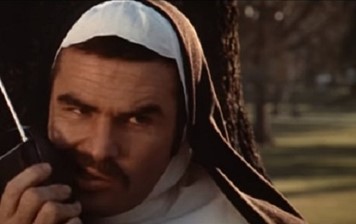
The biggest Massachusetts film of this era is of course Jaws, and Roffman and Arabian chose not to highlight one of the many beach sequences but rather the scene where police chief Brody and the mayor and his flunkies argue while they’re on a small ferry carting a car across the water in Edgartown. Spielberg pulls out to show Brody isolated and literally out of his depth with these townie dolts, but it’s also a portrait of an island town’s infrastructure functioning. The best Massachusetts film of this era I’ve seen is Peter Yates’ Eddie Coyle but very, very close behind is Joan Micklin Silver’s Between The Lines (it is unquestionably the best movie made about journalism, 70s or otherwise). Silver’s camera captures reporters at an alternative weekly venturing into smaller spaces — cramped apartments, dressing rooms for strippers in the Combat Zone, crowded bars with loud bands, a disaster of an office that will produce pangs of homesickness for any journalist — with a casual naturalism, not fetishizing these places but letting the characters’ ease or unease in them tell its own story. The clip shown in MiM follows babyfaced Jeff Goldblum and Bruno Kirby as they seem to walk from Harvard Square into Cheapo Records. That store is actually a mile away in Central Square, but that distance isn’t the point, the stacks of LPs Goldblum shuffles through looking for bootlegs as he feeds the gullible Kirby a line of bullshit patter is.
The 80s see an interesting increase in the supernatural, bookended by Lucio Fulci’s 1981 The House By The Cemetery in Concord and 1989’s cheesy Warlock in the venerable Plimoth Plantation/Patuxet, a replication of Pilgrim settlements. Crime remains strong but mainstreamed, as shown by the numerous clips of the TV show Spenser For Hire, based on Robert Parker’s detective novels. The Commonwealth looks crisper but a bit colder, and while its environments are depicted well they start to slot into The City (with its stodgy but ominous institutional buildings) and The Quaint Towns, with the latter feeling more generic as settings even if they are specifically New England in vibe. The 90s brings a mix of all of the above — period pieces like The Crucible, supernatural claptrap like Hocus Pocus, the yuppie fantasies of Harvard in With Honors, the crime (with a more explosive edge) of Blown Away — before a little movie called Good Will Hunting does the real blowing up in 1997. Gus Van Zant navigates bars similarly to Silver but Matt Damon and Ben Affleck’s script gives a stronger focus to the divide characters feel about who belongs where in Boston and Cambridge, with Affleck in the clip shown in MiM muttering about the Harvahd bar that Damon has dragged him to (that is actually played by Southie’s L Street Tavern). Good Will Hunting was a surprise hit and launched a decade of movies explicitly set in Boston and explicitly about the divide Hunting explores well, about being from a place under siege from outsiders moving in while recognizing the threat as well as the appeal of stasis, of cliche.
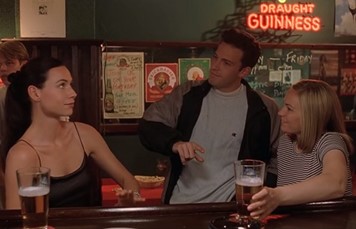
And once again this manifests itself in crime — the Wahlbergian Southie, the underrated Charlestown-set Monument Ave. (far superior to Affleck’s later The Town), the ridiculous Boondock Saints, the dark and moody Lehane adaptations Gone Baby Gone and Mystic River and the Best Picture winner The Departed all make appearances here. At their best these films are focused on finding unique places in Boston — small restaurants and diners, gargantuan edifices like the Tobin Bridge — and letting them be familiar but often confining to the people placed in and around them. “The city is a character” is one of the most derided cliches in criticism but if the city can’t be a character it can be a subject, and this stretch of MiM suggests a desire to show and sell this subject of grim white ethnics and the place that lets them do their grim but compelling deeds. However, this reaches its simultaneous apotheosis and nadir in comedy with the wretched Fever Pitch, about Jimmy Fallon’s “loveable” Sawx fan learning that his team and by extension his town aren’t everything (but of course they really are). The MiM filmmakers’ decision to let scenes play out at length means the excruciating sequence of Drew Barrymore running around the outfield at Fenway plays in its entirety; instead of capturing something real it’s a cliched cartoon.
Every area has cliches of course, and they can be fun to indulge and drill down into — 2010’s Ted and 2013’s The Heat make the most of their spiky comedic aggravated Massholes (The Heat’s scene screened in MiM has a local dope making an extremely off-color and very funny joke about Celtics hero Kevin Garnett) as the baseline filmmaking of the era becomes slicker, capturing surfaces but not a sense of the lives behind them even as film production increased overall. In 2005, Massachusetts introduced a 25 percent tax credit for films made in the state and really began investing in film as an industry, with large-scale studios popping up in the state over the next decade. This led to more filming in general, which still included area-set flicks and movies making the most — or making a hash — of their locations. Wheelman, a nifty heist picture from 2017, eschews landmarks in favor of capturing the boulevards and cracked medians of Boston and Lawrence and the texture of those streets grounds the film’s trapped-in-a-car conceit. In contrast, the biggest laugh in the screening came not during a comedy but from the 2015 horror flick The Possession Of Hannah Grace, where Boston City Hall — the ugliest and most identifiable building in the Commonwealth — is labeled via tacky CGI as “Boston Metro Hospital.” It’s hilarious but it is still a reality reflected through a cheap and cracked mirror.
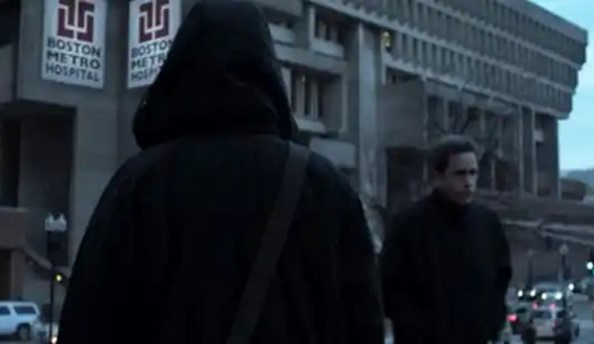
However, as the aughts turn into the teens and 20s, MiM shows more productions using Boston in the same way they use Georgia, as a place to film instead of a place to capture. The woods of Sutton become The Sea Of Trees in Japan, far more egregiously downtown Boston becomes New York City in the 2016 Ghostbusters. A place standing in for somewhere else is as old as the movies themselves and it’s definitely a benefit for lots of local people in the industry (including IATSE and the Teamsters) to have this much work in Massachusetts. But in the overlit digital glare that makes small towns look like sets and city life look like a patio designed by the Cheesecake Factory, in the shot/reverse shots that show torsos and heads instead of bodies in motion, all of these places start to look the same. This comes to a head in 2021’s Free Guy, where Boston’s downtown is turned with very little work into an immersive videogame Anytown — you’d never know where you are and why would you, the point is watching Ryan Reynolds play with some dumb CGI bullshit. Some stuff that isn’t even there in a place that has no soul. (The progression from “multiple movies with James Coburn” to “multiple movies with Ryan Reynolds” charts a course of despair not just for Massachusetts but for cinema in general.)
The present is anodyne, making space for the past to push in. I believe the first period piece in MiM, after Captains Courageous, is The Brink’s Job, William Friedkin’s 1978 telling of a 1950 Boston heist (so much crime!) that was able to make use of many buildings of the 50s still standing at the time. Massachusetts has plenty of old architecture to facilitate stories of the past and several appear during the course of MiM, like the orphanage of The Cider House Rules — itself an earlier example of the state standing in for elsewhere, in this case Maine — to Shutter Island and Little Women. But in the final decade of MiM, period pieces start to become more prevalent. Fiction like Live By Night (2016) and the TV series City On A Hill (2020-22), tales more concretely based on fact like Black Mass (2015) and The Finest Hours (2016) and Chappaquiddick (2017), and these seem familiar — another story of ships at sea and a lot of white ethnic crime. These are more Massachusetts-focused than dreck like 2013’s RIPD or 2020’s The New Mutants, but why are they dipping into the past? Is it because the people there are easier to tell stories about? The most jarring moment in MiM conflates several recent trends, as a sequence from Katherine Bigelow’s 2017 period cop/crime/drama/biopic Detroit play out — large riot scenes were shot not in the Motor City but in the small city of Brockton, presumably because some of its storefronts fit the late 60s setting. This setup is familiar, what is unsettling is how this comes nearly three hours into MiM and the number of Black people on screen in these few minutes equals if not surpasses the number seen on screen until now. That says a lot about 100 years of filmmaking in the Bay State, none of it good.
***
So where do we go from here? In some ways the five movies from 2022 that close MiM offer more of the same, but tweaked. I Wanna Dance With Somebody is another period biopic, but this time about Black people — Whitney Houston flees Boston native Bobby Brown’s limo as it drives through town before the pair reconcile in the clip MiM shows. The young Black heroine of Black Panther: Wakanda Forever extorts a nerd on the campus of MIT while approving Wakandans look on, as a multi-billion-dollar comic book enterprise swings through the Bay State on the way to a made-up land filled with CGI wonders. Speaking of which, the inescapable Ryan Reynolds dances with Will Ferrell through a gussied-up historical Boston street in Spirited — said street is apparently meant to be in New York City, of course. The selection from Bros is shot with the indifference of most modern comedies but at least it’s set in its colorful location of Provincetown, a good choice for a romcom with gay leads who actually kiss onscreen.
And then there’s Confess, Fletch — a legacy sequel/update and book adaptation that revolves around crime. It hits a bunch of current cliches but it’s a movie I really liked when I saw it two years ago and the clips in MiM made me laugh again, and they show how a good filmmaker like Greg Mottola can still use Massachusetts and in particular Boston as a place instead of a backdrop. In one sequence, the hero uses a twisty route through the city’s ritzy neighborhoods into the nearby interstate on-ramp/tunnel to lose police on his trail (never mind that the interior is shot in a different Boston tunnel). Even better is how Fletch takes a quick detour to Chinatown — a historic area that I believe only appears elsewhere in MiM in a clip from SMILF (a 2010s TV show whose title led to an outraged city councilor demanding its ads be taken down from public property) — and surreptitiously asks some local vendors where he might get some fireworks. The answer, in a tone of brusque contempt: “New Hampshire.”
It’s a great (and accurate) gag that plays on assumptions and contradictions and real locations. I’m glad it’s there to let someone 100 years from now see a glimpse of what was, but I’m even happier it’s on screen being true about the here and now. If movies are going to be made in Massachusetts, they should show something real about the people and places here, even if the unreality of a giant shark or demonic warlock or (sigh) living videogame is in the mix. And that means all of the places, and all of the people. At the end of Made In Massachusetts, the filmmakers passed out a list of all the movies they took clips from and now I have a whole bunch of films to check out and see parts of the state I’ve made my home. I hope the next hundred years shows me more, not less.

